Comprehensive Report: Collaborative Partnerships and Relationships
VerifiedAdded on 2022/10/17
|13
|3075
|13
Report
AI Summary
This report provides a comprehensive overview of collaborative partnerships and relationships within an organizational context. It begins by exploring legislative and regulatory frameworks, followed by definitions of key organizational terms such as mission, purpose, values, and strategies. The report then delves into techniques for cultivating collaborative relationships and partnerships, including joint planning, mutual consultation, and data sharing. It also outlines various data collection methods (interviews, questionnaires, focus groups) and analytical tools like PESTLE analysis, Porter's Five Forces, and competitive analysis for understanding the external business environment. The report further examines emotional intelligence and its impact on individual and team effectiveness, as well as the stages involved in effective change management and organizational transformation. Finally, it discusses principles for resolving conflict and suggests activities to encourage staff collaboration.
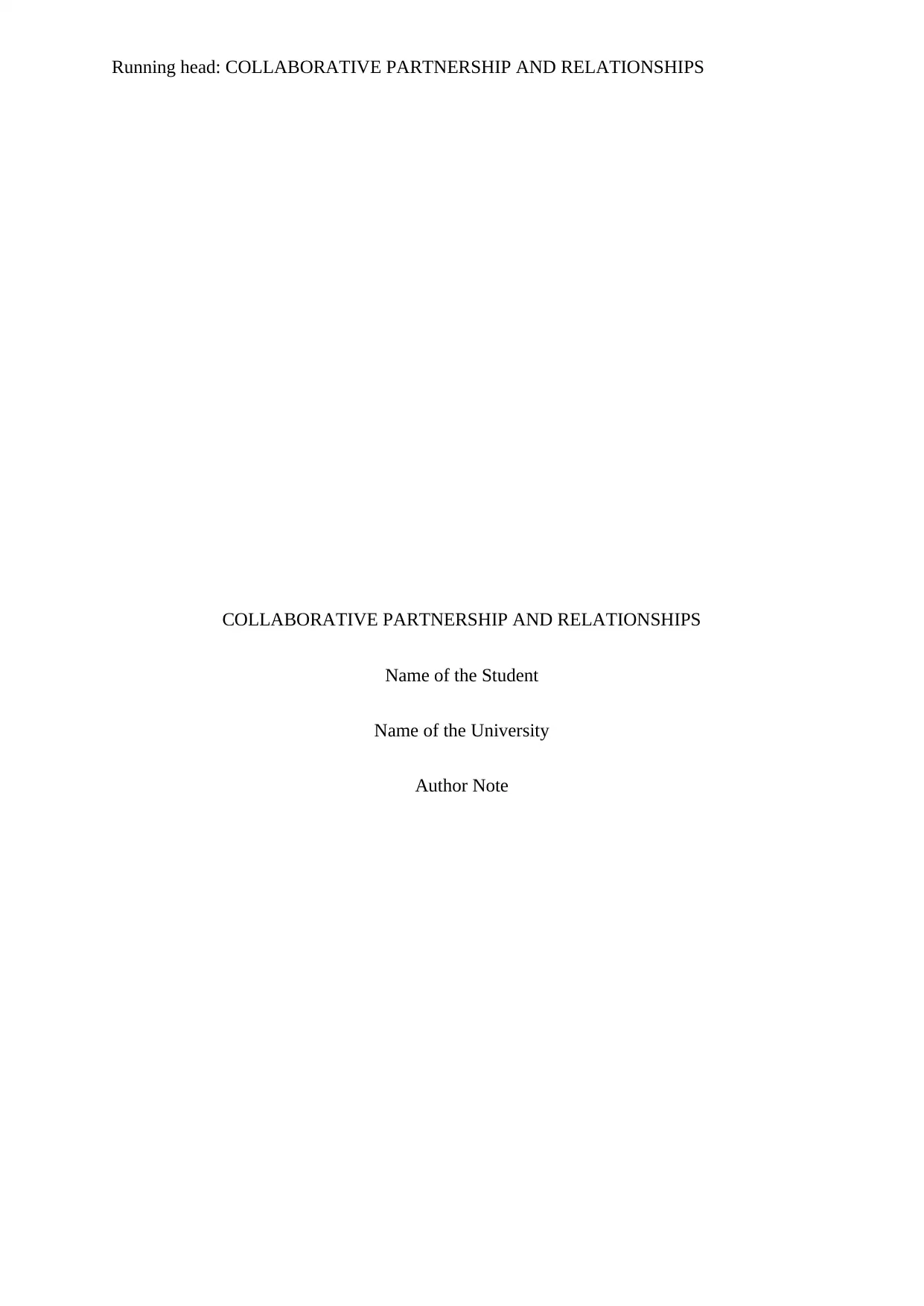
Running head: COLLABORATIVE PARTNERSHIP AND RELATIONSHIPS
COLLABORATIVE PARTNERSHIP AND RELATIONSHIPS
Name of the Student
Name of the University
Author Note
COLLABORATIVE PARTNERSHIP AND RELATIONSHIPS
Name of the Student
Name of the University
Author Note
Paraphrase This Document
Need a fresh take? Get an instant paraphrase of this document with our AI Paraphraser
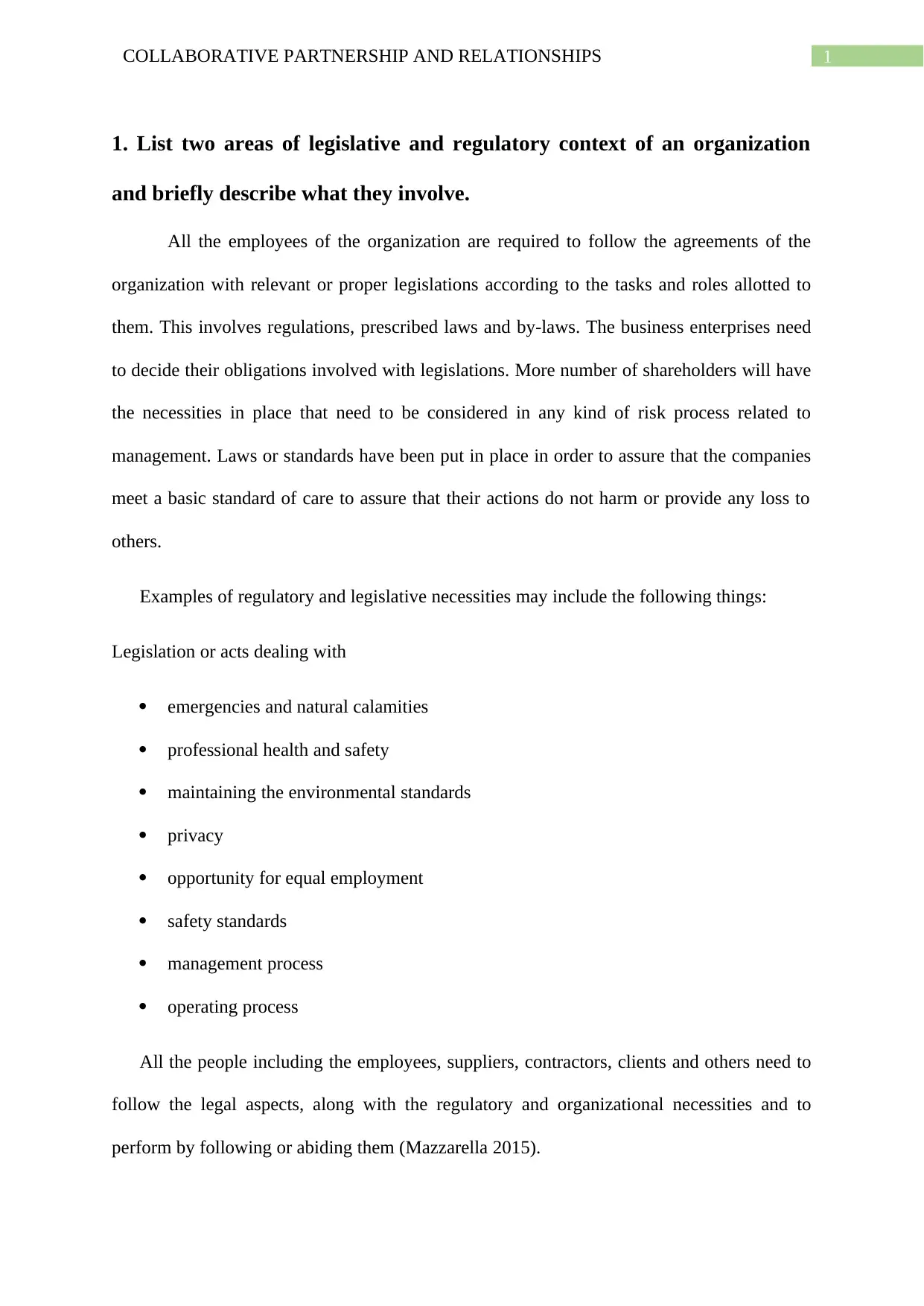
1COLLABORATIVE PARTNERSHIP AND RELATIONSHIPS
1. List two areas of legislative and regulatory context of an organization
and briefly describe what they involve.
All the employees of the organization are required to follow the agreements of the
organization with relevant or proper legislations according to the tasks and roles allotted to
them. This involves regulations, prescribed laws and by-laws. The business enterprises need
to decide their obligations involved with legislations. More number of shareholders will have
the necessities in place that need to be considered in any kind of risk process related to
management. Laws or standards have been put in place in order to assure that the companies
meet a basic standard of care to assure that their actions do not harm or provide any loss to
others.
Examples of regulatory and legislative necessities may include the following things:
Legislation or acts dealing with
emergencies and natural calamities
professional health and safety
maintaining the environmental standards
privacy
opportunity for equal employment
safety standards
management process
operating process
All the people including the employees, suppliers, contractors, clients and others need to
follow the legal aspects, along with the regulatory and organizational necessities and to
perform by following or abiding them (Mazzarella 2015).
1. List two areas of legislative and regulatory context of an organization
and briefly describe what they involve.
All the employees of the organization are required to follow the agreements of the
organization with relevant or proper legislations according to the tasks and roles allotted to
them. This involves regulations, prescribed laws and by-laws. The business enterprises need
to decide their obligations involved with legislations. More number of shareholders will have
the necessities in place that need to be considered in any kind of risk process related to
management. Laws or standards have been put in place in order to assure that the companies
meet a basic standard of care to assure that their actions do not harm or provide any loss to
others.
Examples of regulatory and legislative necessities may include the following things:
Legislation or acts dealing with
emergencies and natural calamities
professional health and safety
maintaining the environmental standards
privacy
opportunity for equal employment
safety standards
management process
operating process
All the people including the employees, suppliers, contractors, clients and others need to
follow the legal aspects, along with the regulatory and organizational necessities and to
perform by following or abiding them (Mazzarella 2015).
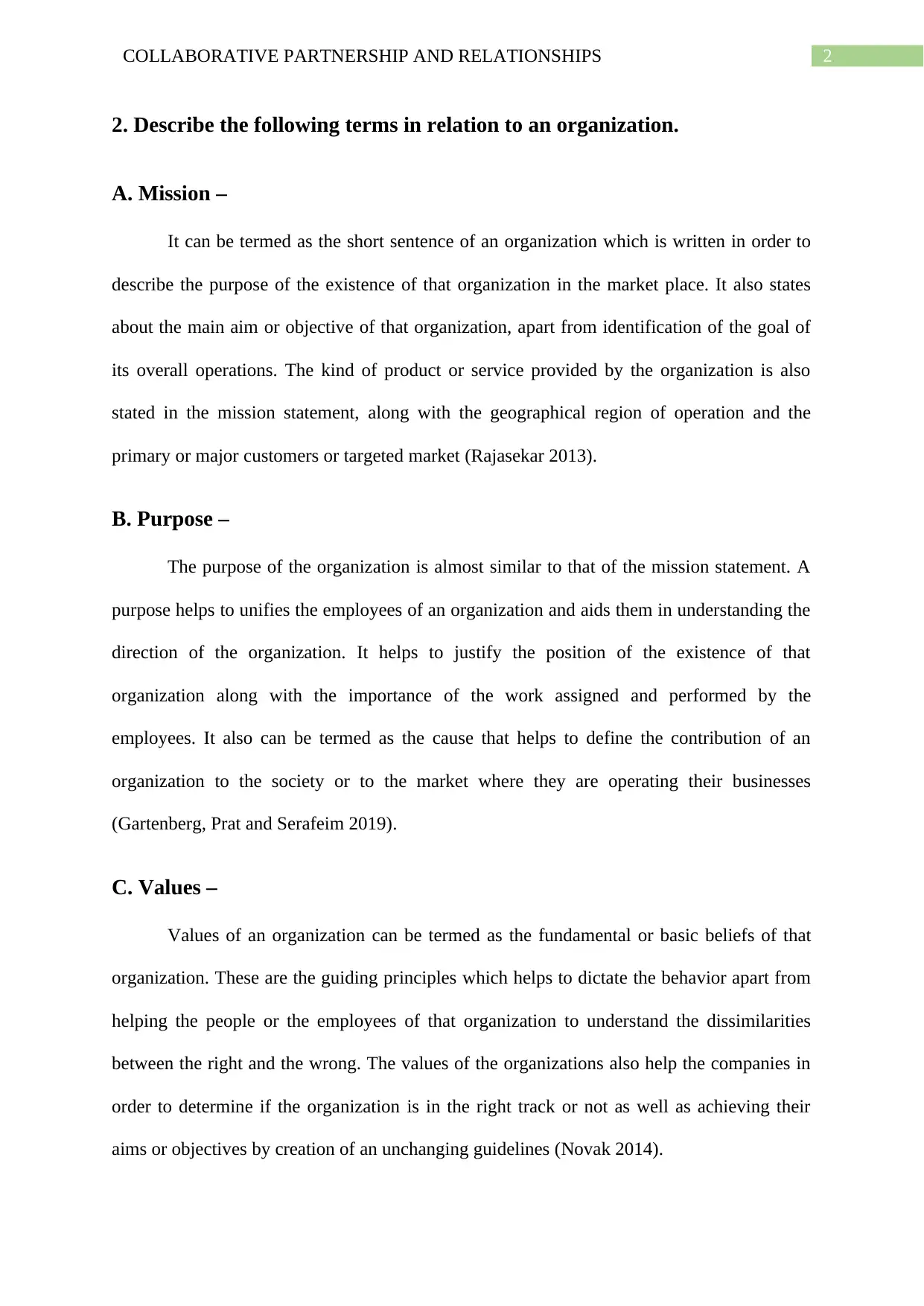
2COLLABORATIVE PARTNERSHIP AND RELATIONSHIPS
2. Describe the following terms in relation to an organization.
A. Mission –
It can be termed as the short sentence of an organization which is written in order to
describe the purpose of the existence of that organization in the market place. It also states
about the main aim or objective of that organization, apart from identification of the goal of
its overall operations. The kind of product or service provided by the organization is also
stated in the mission statement, along with the geographical region of operation and the
primary or major customers or targeted market (Rajasekar 2013).
B. Purpose –
The purpose of the organization is almost similar to that of the mission statement. A
purpose helps to unifies the employees of an organization and aids them in understanding the
direction of the organization. It helps to justify the position of the existence of that
organization along with the importance of the work assigned and performed by the
employees. It also can be termed as the cause that helps to define the contribution of an
organization to the society or to the market where they are operating their businesses
(Gartenberg, Prat and Serafeim 2019).
C. Values –
Values of an organization can be termed as the fundamental or basic beliefs of that
organization. These are the guiding principles which helps to dictate the behavior apart from
helping the people or the employees of that organization to understand the dissimilarities
between the right and the wrong. The values of the organizations also help the companies in
order to determine if the organization is in the right track or not as well as achieving their
aims or objectives by creation of an unchanging guidelines (Novak 2014).
2. Describe the following terms in relation to an organization.
A. Mission –
It can be termed as the short sentence of an organization which is written in order to
describe the purpose of the existence of that organization in the market place. It also states
about the main aim or objective of that organization, apart from identification of the goal of
its overall operations. The kind of product or service provided by the organization is also
stated in the mission statement, along with the geographical region of operation and the
primary or major customers or targeted market (Rajasekar 2013).
B. Purpose –
The purpose of the organization is almost similar to that of the mission statement. A
purpose helps to unifies the employees of an organization and aids them in understanding the
direction of the organization. It helps to justify the position of the existence of that
organization along with the importance of the work assigned and performed by the
employees. It also can be termed as the cause that helps to define the contribution of an
organization to the society or to the market where they are operating their businesses
(Gartenberg, Prat and Serafeim 2019).
C. Values –
Values of an organization can be termed as the fundamental or basic beliefs of that
organization. These are the guiding principles which helps to dictate the behavior apart from
helping the people or the employees of that organization to understand the dissimilarities
between the right and the wrong. The values of the organizations also help the companies in
order to determine if the organization is in the right track or not as well as achieving their
aims or objectives by creation of an unchanging guidelines (Novak 2014).
⊘ This is a preview!⊘
Do you want full access?
Subscribe today to unlock all pages.

Trusted by 1+ million students worldwide
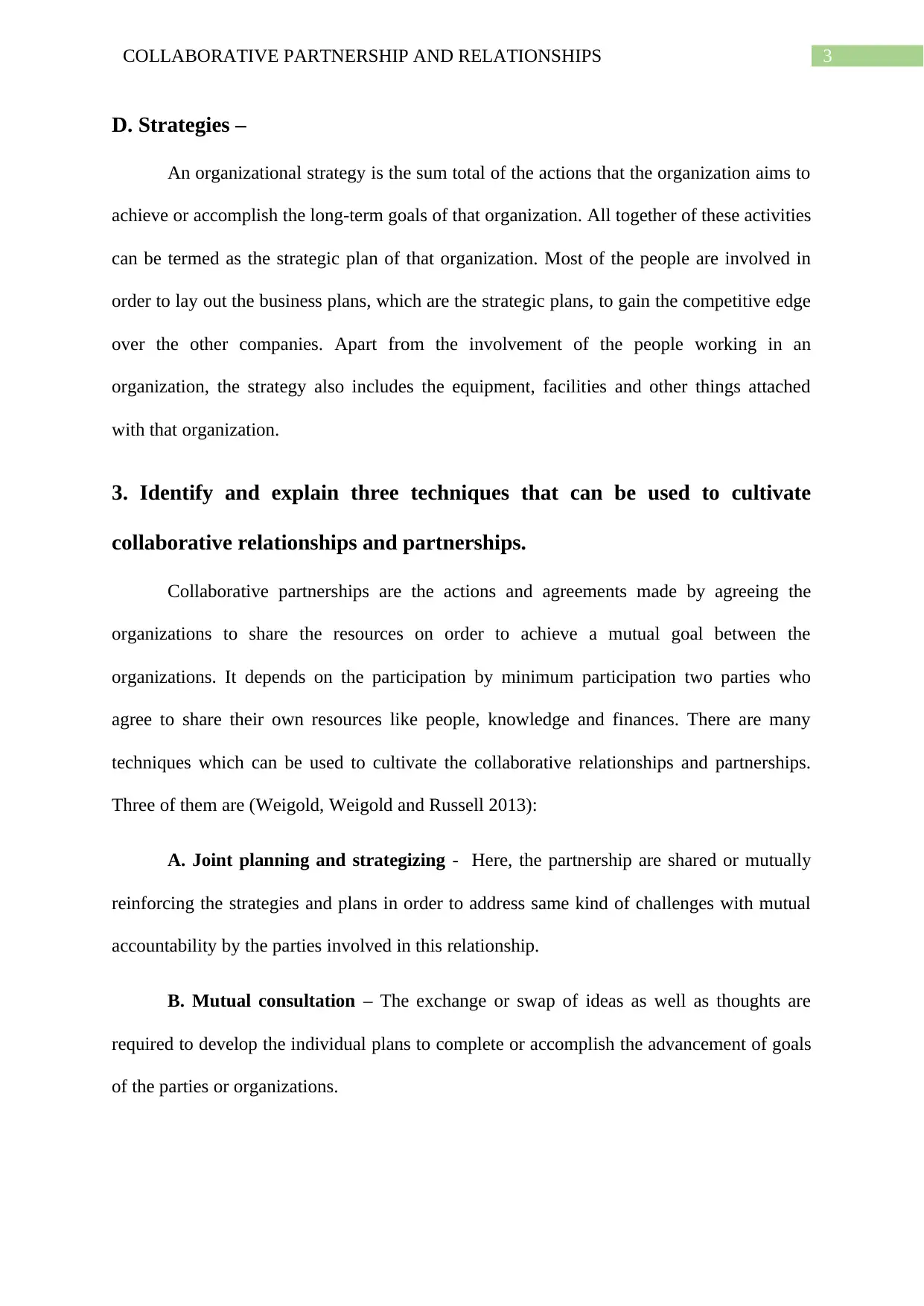
3COLLABORATIVE PARTNERSHIP AND RELATIONSHIPS
D. Strategies –
An organizational strategy is the sum total of the actions that the organization aims to
achieve or accomplish the long-term goals of that organization. All together of these activities
can be termed as the strategic plan of that organization. Most of the people are involved in
order to lay out the business plans, which are the strategic plans, to gain the competitive edge
over the other companies. Apart from the involvement of the people working in an
organization, the strategy also includes the equipment, facilities and other things attached
with that organization.
3. Identify and explain three techniques that can be used to cultivate
collaborative relationships and partnerships.
Collaborative partnerships are the actions and agreements made by agreeing the
organizations to share the resources on order to achieve a mutual goal between the
organizations. It depends on the participation by minimum participation two parties who
agree to share their own resources like people, knowledge and finances. There are many
techniques which can be used to cultivate the collaborative relationships and partnerships.
Three of them are (Weigold, Weigold and Russell 2013):
A. Joint planning and strategizing - Here, the partnership are shared or mutually
reinforcing the strategies and plans in order to address same kind of challenges with mutual
accountability by the parties involved in this relationship.
B. Mutual consultation – The exchange or swap of ideas as well as thoughts are
required to develop the individual plans to complete or accomplish the advancement of goals
of the parties or organizations.
D. Strategies –
An organizational strategy is the sum total of the actions that the organization aims to
achieve or accomplish the long-term goals of that organization. All together of these activities
can be termed as the strategic plan of that organization. Most of the people are involved in
order to lay out the business plans, which are the strategic plans, to gain the competitive edge
over the other companies. Apart from the involvement of the people working in an
organization, the strategy also includes the equipment, facilities and other things attached
with that organization.
3. Identify and explain three techniques that can be used to cultivate
collaborative relationships and partnerships.
Collaborative partnerships are the actions and agreements made by agreeing the
organizations to share the resources on order to achieve a mutual goal between the
organizations. It depends on the participation by minimum participation two parties who
agree to share their own resources like people, knowledge and finances. There are many
techniques which can be used to cultivate the collaborative relationships and partnerships.
Three of them are (Weigold, Weigold and Russell 2013):
A. Joint planning and strategizing - Here, the partnership are shared or mutually
reinforcing the strategies and plans in order to address same kind of challenges with mutual
accountability by the parties involved in this relationship.
B. Mutual consultation – The exchange or swap of ideas as well as thoughts are
required to develop the individual plans to complete or accomplish the advancement of goals
of the parties or organizations.
Paraphrase This Document
Need a fresh take? Get an instant paraphrase of this document with our AI Paraphraser
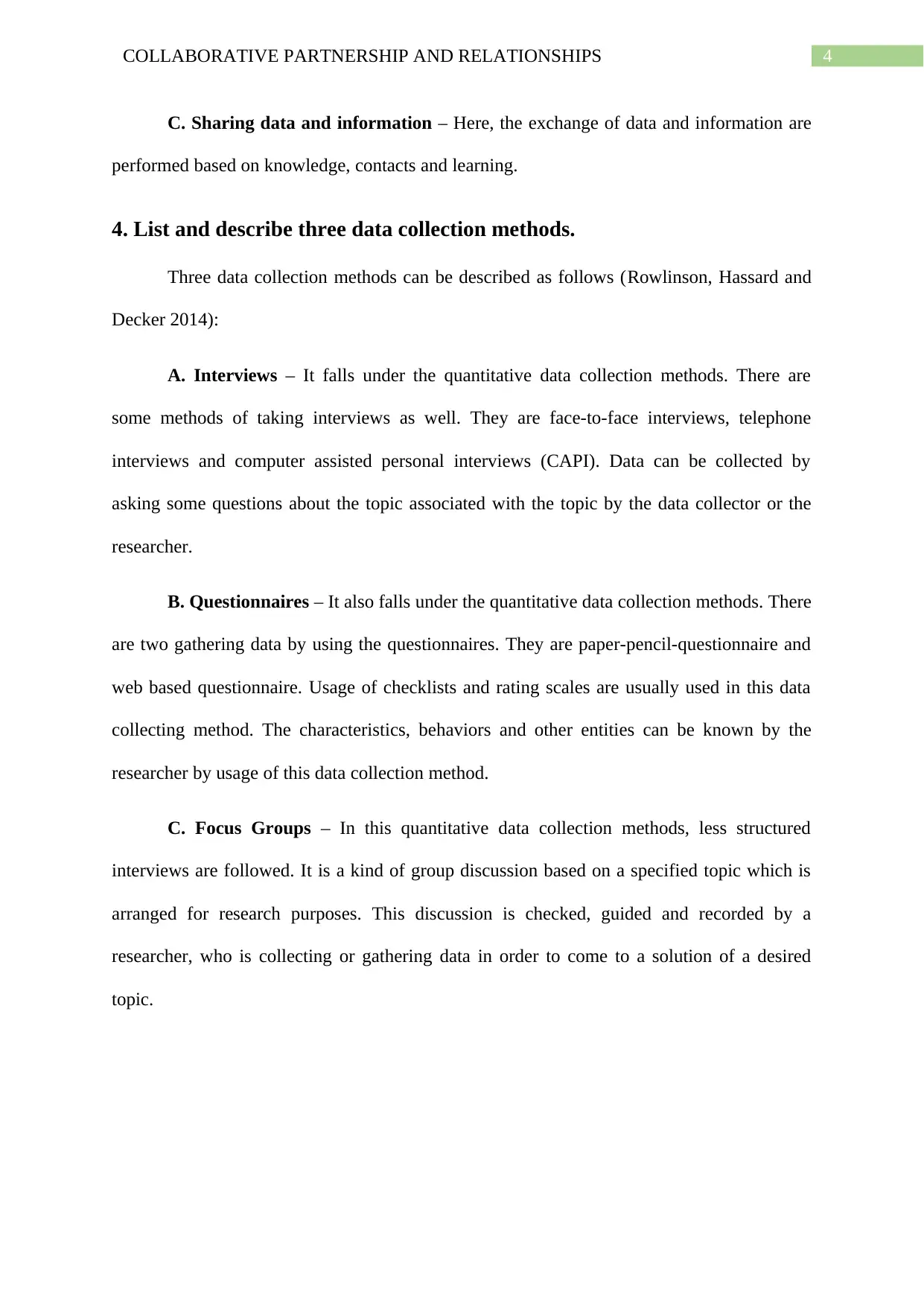
4COLLABORATIVE PARTNERSHIP AND RELATIONSHIPS
C. Sharing data and information – Here, the exchange of data and information are
performed based on knowledge, contacts and learning.
4. List and describe three data collection methods.
Three data collection methods can be described as follows (Rowlinson, Hassard and
Decker 2014):
A. Interviews – It falls under the quantitative data collection methods. There are
some methods of taking interviews as well. They are face-to-face interviews, telephone
interviews and computer assisted personal interviews (CAPI). Data can be collected by
asking some questions about the topic associated with the topic by the data collector or the
researcher.
B. Questionnaires – It also falls under the quantitative data collection methods. There
are two gathering data by using the questionnaires. They are paper-pencil-questionnaire and
web based questionnaire. Usage of checklists and rating scales are usually used in this data
collecting method. The characteristics, behaviors and other entities can be known by the
researcher by usage of this data collection method.
C. Focus Groups – In this quantitative data collection methods, less structured
interviews are followed. It is a kind of group discussion based on a specified topic which is
arranged for research purposes. This discussion is checked, guided and recorded by a
researcher, who is collecting or gathering data in order to come to a solution of a desired
topic.
C. Sharing data and information – Here, the exchange of data and information are
performed based on knowledge, contacts and learning.
4. List and describe three data collection methods.
Three data collection methods can be described as follows (Rowlinson, Hassard and
Decker 2014):
A. Interviews – It falls under the quantitative data collection methods. There are
some methods of taking interviews as well. They are face-to-face interviews, telephone
interviews and computer assisted personal interviews (CAPI). Data can be collected by
asking some questions about the topic associated with the topic by the data collector or the
researcher.
B. Questionnaires – It also falls under the quantitative data collection methods. There
are two gathering data by using the questionnaires. They are paper-pencil-questionnaire and
web based questionnaire. Usage of checklists and rating scales are usually used in this data
collecting method. The characteristics, behaviors and other entities can be known by the
researcher by usage of this data collection method.
C. Focus Groups – In this quantitative data collection methods, less structured
interviews are followed. It is a kind of group discussion based on a specified topic which is
arranged for research purposes. This discussion is checked, guided and recorded by a
researcher, who is collecting or gathering data in order to come to a solution of a desired
topic.
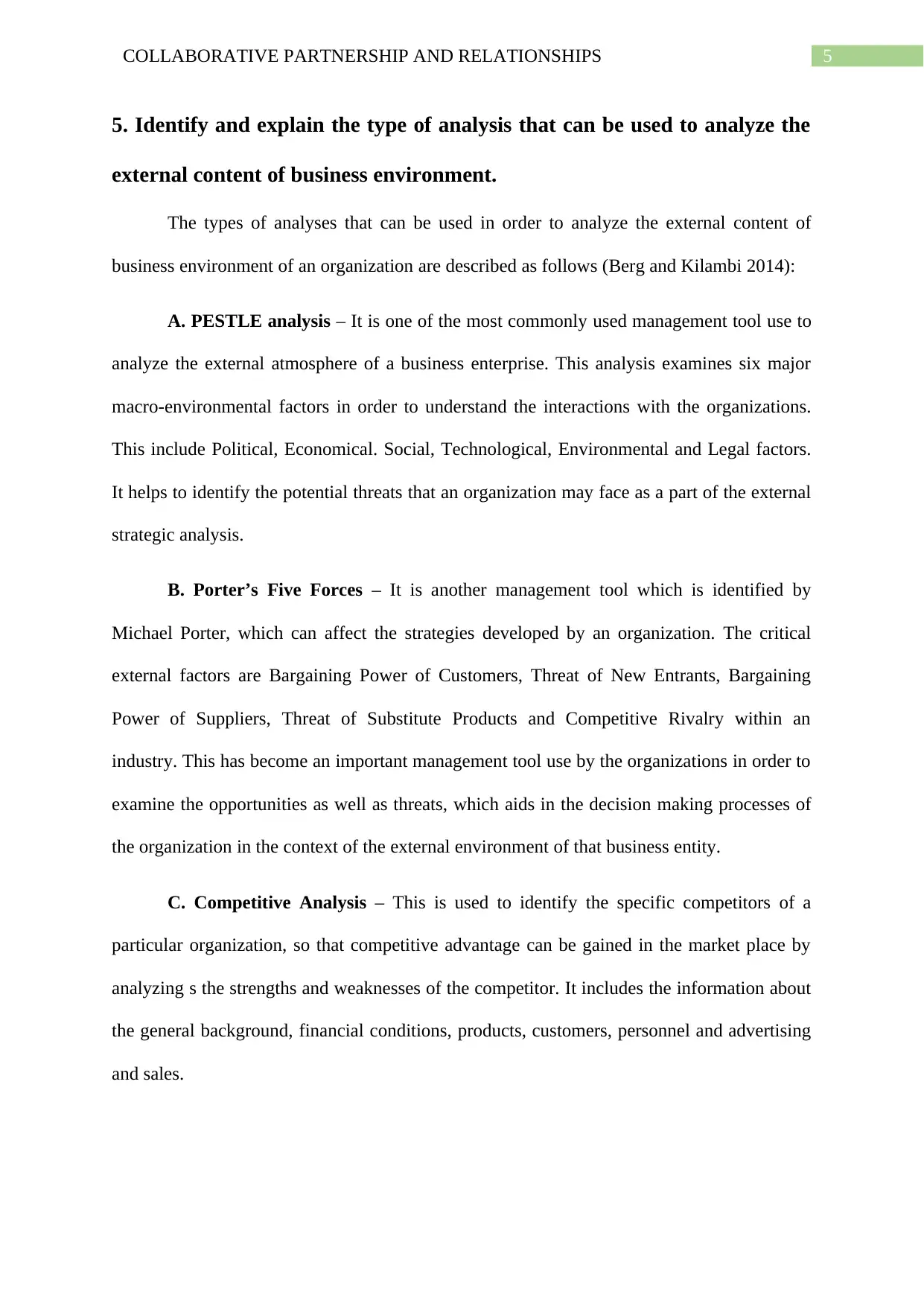
5COLLABORATIVE PARTNERSHIP AND RELATIONSHIPS
5. Identify and explain the type of analysis that can be used to analyze the
external content of business environment.
The types of analyses that can be used in order to analyze the external content of
business environment of an organization are described as follows (Berg and Kilambi 2014):
A. PESTLE analysis – It is one of the most commonly used management tool use to
analyze the external atmosphere of a business enterprise. This analysis examines six major
macro-environmental factors in order to understand the interactions with the organizations.
This include Political, Economical. Social, Technological, Environmental and Legal factors.
It helps to identify the potential threats that an organization may face as a part of the external
strategic analysis.
B. Porter’s Five Forces – It is another management tool which is identified by
Michael Porter, which can affect the strategies developed by an organization. The critical
external factors are Bargaining Power of Customers, Threat of New Entrants, Bargaining
Power of Suppliers, Threat of Substitute Products and Competitive Rivalry within an
industry. This has become an important management tool use by the organizations in order to
examine the opportunities as well as threats, which aids in the decision making processes of
the organization in the context of the external environment of that business entity.
C. Competitive Analysis – This is used to identify the specific competitors of a
particular organization, so that competitive advantage can be gained in the market place by
analyzing s the strengths and weaknesses of the competitor. It includes the information about
the general background, financial conditions, products, customers, personnel and advertising
and sales.
5. Identify and explain the type of analysis that can be used to analyze the
external content of business environment.
The types of analyses that can be used in order to analyze the external content of
business environment of an organization are described as follows (Berg and Kilambi 2014):
A. PESTLE analysis – It is one of the most commonly used management tool use to
analyze the external atmosphere of a business enterprise. This analysis examines six major
macro-environmental factors in order to understand the interactions with the organizations.
This include Political, Economical. Social, Technological, Environmental and Legal factors.
It helps to identify the potential threats that an organization may face as a part of the external
strategic analysis.
B. Porter’s Five Forces – It is another management tool which is identified by
Michael Porter, which can affect the strategies developed by an organization. The critical
external factors are Bargaining Power of Customers, Threat of New Entrants, Bargaining
Power of Suppliers, Threat of Substitute Products and Competitive Rivalry within an
industry. This has become an important management tool use by the organizations in order to
examine the opportunities as well as threats, which aids in the decision making processes of
the organization in the context of the external environment of that business entity.
C. Competitive Analysis – This is used to identify the specific competitors of a
particular organization, so that competitive advantage can be gained in the market place by
analyzing s the strengths and weaknesses of the competitor. It includes the information about
the general background, financial conditions, products, customers, personnel and advertising
and sales.
⊘ This is a preview!⊘
Do you want full access?
Subscribe today to unlock all pages.

Trusted by 1+ million students worldwide
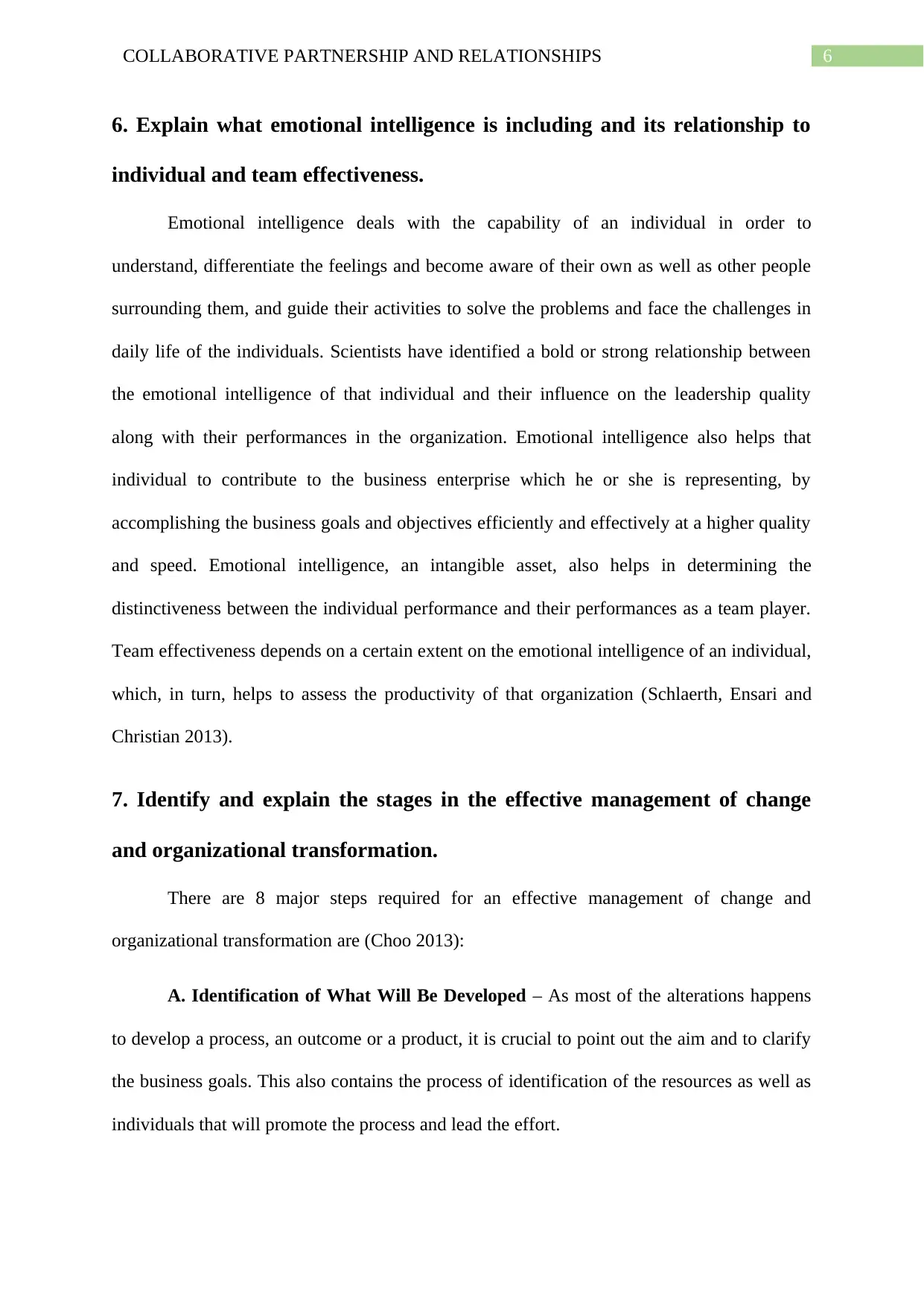
6COLLABORATIVE PARTNERSHIP AND RELATIONSHIPS
6. Explain what emotional intelligence is including and its relationship to
individual and team effectiveness.
Emotional intelligence deals with the capability of an individual in order to
understand, differentiate the feelings and become aware of their own as well as other people
surrounding them, and guide their activities to solve the problems and face the challenges in
daily life of the individuals. Scientists have identified a bold or strong relationship between
the emotional intelligence of that individual and their influence on the leadership quality
along with their performances in the organization. Emotional intelligence also helps that
individual to contribute to the business enterprise which he or she is representing, by
accomplishing the business goals and objectives efficiently and effectively at a higher quality
and speed. Emotional intelligence, an intangible asset, also helps in determining the
distinctiveness between the individual performance and their performances as a team player.
Team effectiveness depends on a certain extent on the emotional intelligence of an individual,
which, in turn, helps to assess the productivity of that organization (Schlaerth, Ensari and
Christian 2013).
7. Identify and explain the stages in the effective management of change
and organizational transformation.
There are 8 major steps required for an effective management of change and
organizational transformation are (Choo 2013):
A. Identification of What Will Be Developed – As most of the alterations happens
to develop a process, an outcome or a product, it is crucial to point out the aim and to clarify
the business goals. This also contains the process of identification of the resources as well as
individuals that will promote the process and lead the effort.
6. Explain what emotional intelligence is including and its relationship to
individual and team effectiveness.
Emotional intelligence deals with the capability of an individual in order to
understand, differentiate the feelings and become aware of their own as well as other people
surrounding them, and guide their activities to solve the problems and face the challenges in
daily life of the individuals. Scientists have identified a bold or strong relationship between
the emotional intelligence of that individual and their influence on the leadership quality
along with their performances in the organization. Emotional intelligence also helps that
individual to contribute to the business enterprise which he or she is representing, by
accomplishing the business goals and objectives efficiently and effectively at a higher quality
and speed. Emotional intelligence, an intangible asset, also helps in determining the
distinctiveness between the individual performance and their performances as a team player.
Team effectiveness depends on a certain extent on the emotional intelligence of an individual,
which, in turn, helps to assess the productivity of that organization (Schlaerth, Ensari and
Christian 2013).
7. Identify and explain the stages in the effective management of change
and organizational transformation.
There are 8 major steps required for an effective management of change and
organizational transformation are (Choo 2013):
A. Identification of What Will Be Developed – As most of the alterations happens
to develop a process, an outcome or a product, it is crucial to point out the aim and to clarify
the business goals. This also contains the process of identification of the resources as well as
individuals that will promote the process and lead the effort.
Paraphrase This Document
Need a fresh take? Get an instant paraphrase of this document with our AI Paraphraser
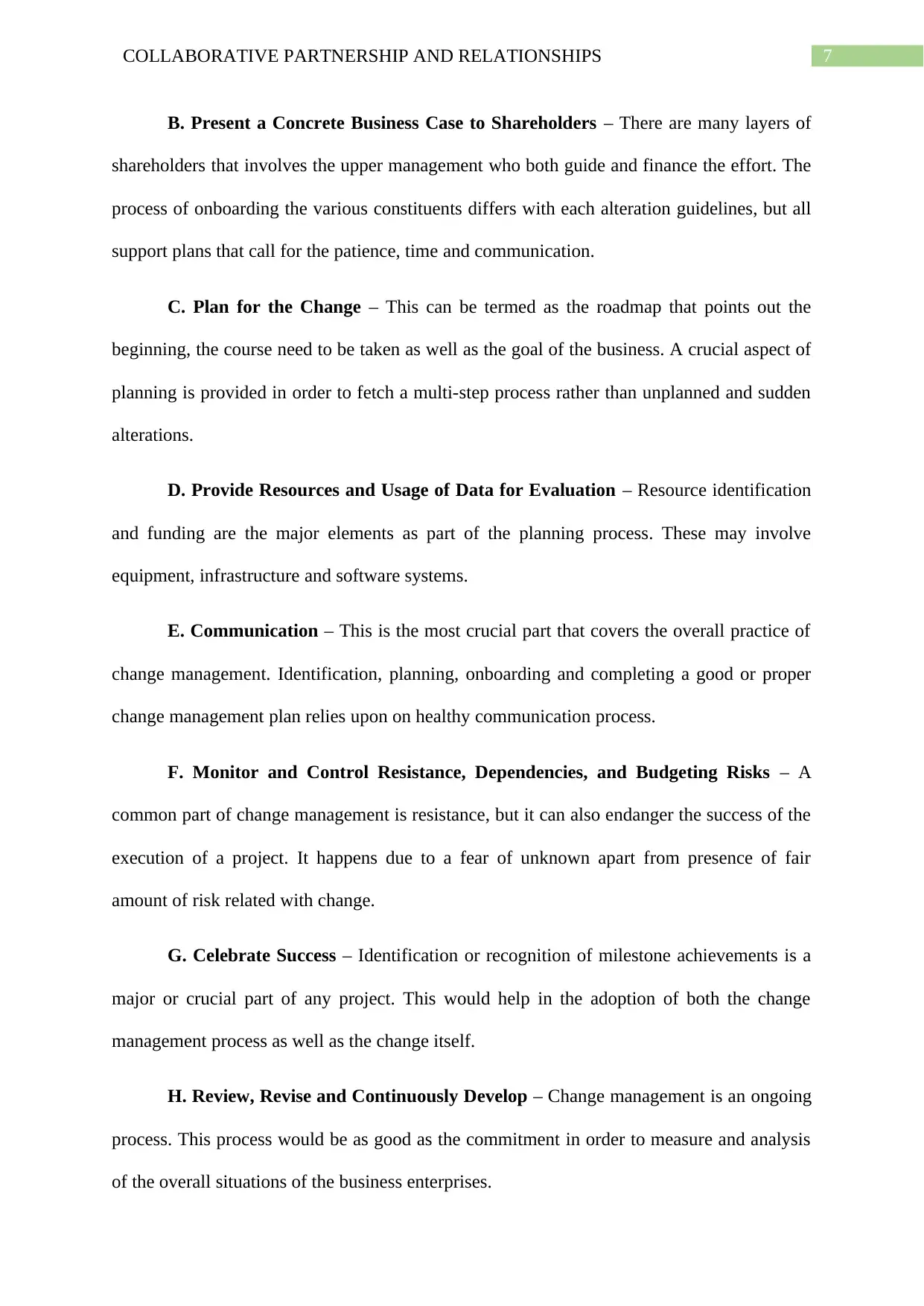
7COLLABORATIVE PARTNERSHIP AND RELATIONSHIPS
B. Present a Concrete Business Case to Shareholders – There are many layers of
shareholders that involves the upper management who both guide and finance the effort. The
process of onboarding the various constituents differs with each alteration guidelines, but all
support plans that call for the patience, time and communication.
C. Plan for the Change – This can be termed as the roadmap that points out the
beginning, the course need to be taken as well as the goal of the business. A crucial aspect of
planning is provided in order to fetch a multi-step process rather than unplanned and sudden
alterations.
D. Provide Resources and Usage of Data for Evaluation – Resource identification
and funding are the major elements as part of the planning process. These may involve
equipment, infrastructure and software systems.
E. Communication – This is the most crucial part that covers the overall practice of
change management. Identification, planning, onboarding and completing a good or proper
change management plan relies upon on healthy communication process.
F. Monitor and Control Resistance, Dependencies, and Budgeting Risks – A
common part of change management is resistance, but it can also endanger the success of the
execution of a project. It happens due to a fear of unknown apart from presence of fair
amount of risk related with change.
G. Celebrate Success – Identification or recognition of milestone achievements is a
major or crucial part of any project. This would help in the adoption of both the change
management process as well as the change itself.
H. Review, Revise and Continuously Develop – Change management is an ongoing
process. This process would be as good as the commitment in order to measure and analysis
of the overall situations of the business enterprises.
B. Present a Concrete Business Case to Shareholders – There are many layers of
shareholders that involves the upper management who both guide and finance the effort. The
process of onboarding the various constituents differs with each alteration guidelines, but all
support plans that call for the patience, time and communication.
C. Plan for the Change – This can be termed as the roadmap that points out the
beginning, the course need to be taken as well as the goal of the business. A crucial aspect of
planning is provided in order to fetch a multi-step process rather than unplanned and sudden
alterations.
D. Provide Resources and Usage of Data for Evaluation – Resource identification
and funding are the major elements as part of the planning process. These may involve
equipment, infrastructure and software systems.
E. Communication – This is the most crucial part that covers the overall practice of
change management. Identification, planning, onboarding and completing a good or proper
change management plan relies upon on healthy communication process.
F. Monitor and Control Resistance, Dependencies, and Budgeting Risks – A
common part of change management is resistance, but it can also endanger the success of the
execution of a project. It happens due to a fear of unknown apart from presence of fair
amount of risk related with change.
G. Celebrate Success – Identification or recognition of milestone achievements is a
major or crucial part of any project. This would help in the adoption of both the change
management process as well as the change itself.
H. Review, Revise and Continuously Develop – Change management is an ongoing
process. This process would be as good as the commitment in order to measure and analysis
of the overall situations of the business enterprises.
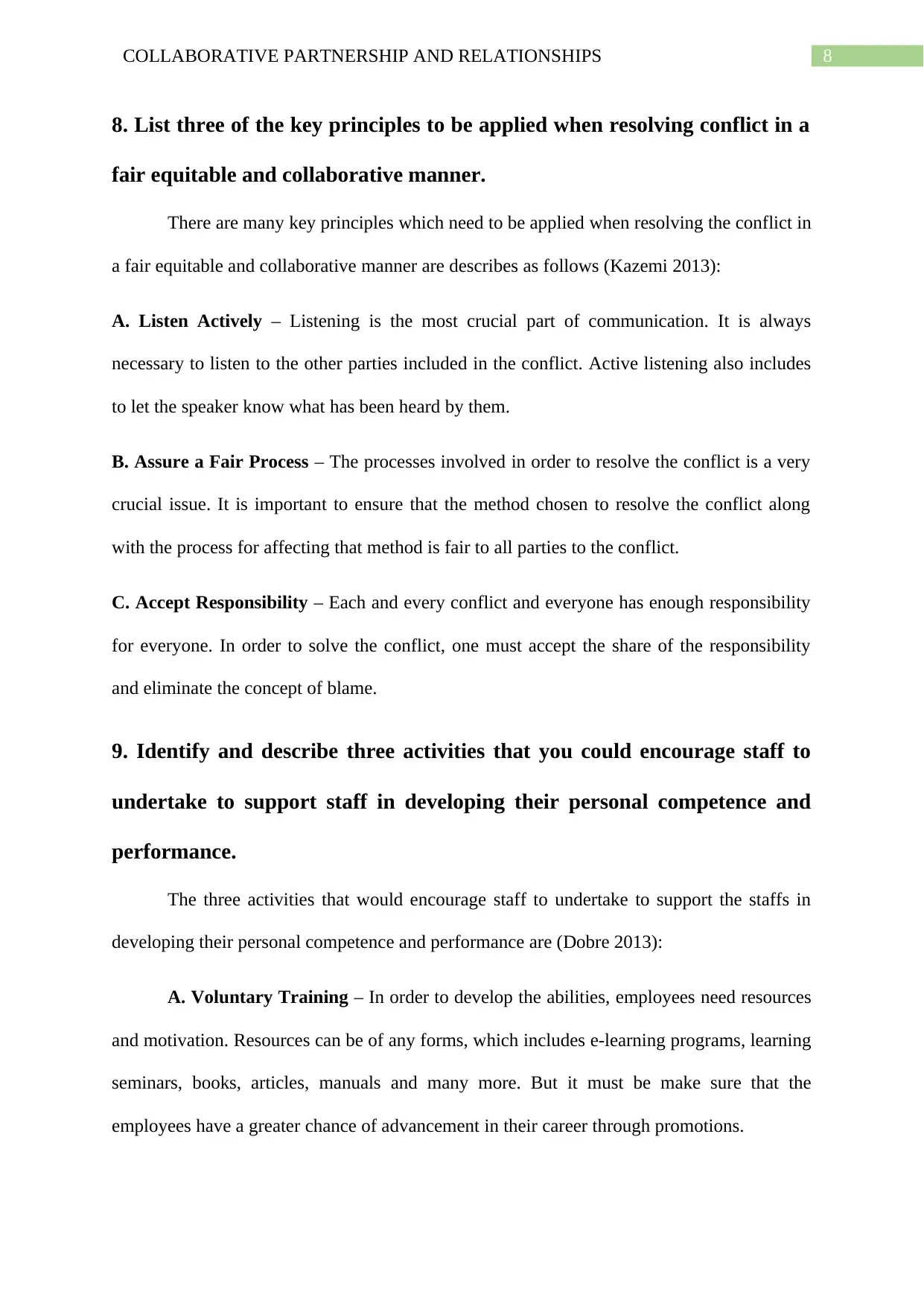
8COLLABORATIVE PARTNERSHIP AND RELATIONSHIPS
8. List three of the key principles to be applied when resolving conflict in a
fair equitable and collaborative manner.
There are many key principles which need to be applied when resolving the conflict in
a fair equitable and collaborative manner are describes as follows (Kazemi 2013):
A. Listen Actively – Listening is the most crucial part of communication. It is always
necessary to listen to the other parties included in the conflict. Active listening also includes
to let the speaker know what has been heard by them.
B. Assure a Fair Process – The processes involved in order to resolve the conflict is a very
crucial issue. It is important to ensure that the method chosen to resolve the conflict along
with the process for affecting that method is fair to all parties to the conflict.
C. Accept Responsibility – Each and every conflict and everyone has enough responsibility
for everyone. In order to solve the conflict, one must accept the share of the responsibility
and eliminate the concept of blame.
9. Identify and describe three activities that you could encourage staff to
undertake to support staff in developing their personal competence and
performance.
The three activities that would encourage staff to undertake to support the staffs in
developing their personal competence and performance are (Dobre 2013):
A. Voluntary Training – In order to develop the abilities, employees need resources
and motivation. Resources can be of any forms, which includes e-learning programs, learning
seminars, books, articles, manuals and many more. But it must be make sure that the
employees have a greater chance of advancement in their career through promotions.
8. List three of the key principles to be applied when resolving conflict in a
fair equitable and collaborative manner.
There are many key principles which need to be applied when resolving the conflict in
a fair equitable and collaborative manner are describes as follows (Kazemi 2013):
A. Listen Actively – Listening is the most crucial part of communication. It is always
necessary to listen to the other parties included in the conflict. Active listening also includes
to let the speaker know what has been heard by them.
B. Assure a Fair Process – The processes involved in order to resolve the conflict is a very
crucial issue. It is important to ensure that the method chosen to resolve the conflict along
with the process for affecting that method is fair to all parties to the conflict.
C. Accept Responsibility – Each and every conflict and everyone has enough responsibility
for everyone. In order to solve the conflict, one must accept the share of the responsibility
and eliminate the concept of blame.
9. Identify and describe three activities that you could encourage staff to
undertake to support staff in developing their personal competence and
performance.
The three activities that would encourage staff to undertake to support the staffs in
developing their personal competence and performance are (Dobre 2013):
A. Voluntary Training – In order to develop the abilities, employees need resources
and motivation. Resources can be of any forms, which includes e-learning programs, learning
seminars, books, articles, manuals and many more. But it must be make sure that the
employees have a greater chance of advancement in their career through promotions.
⊘ This is a preview!⊘
Do you want full access?
Subscribe today to unlock all pages.

Trusted by 1+ million students worldwide
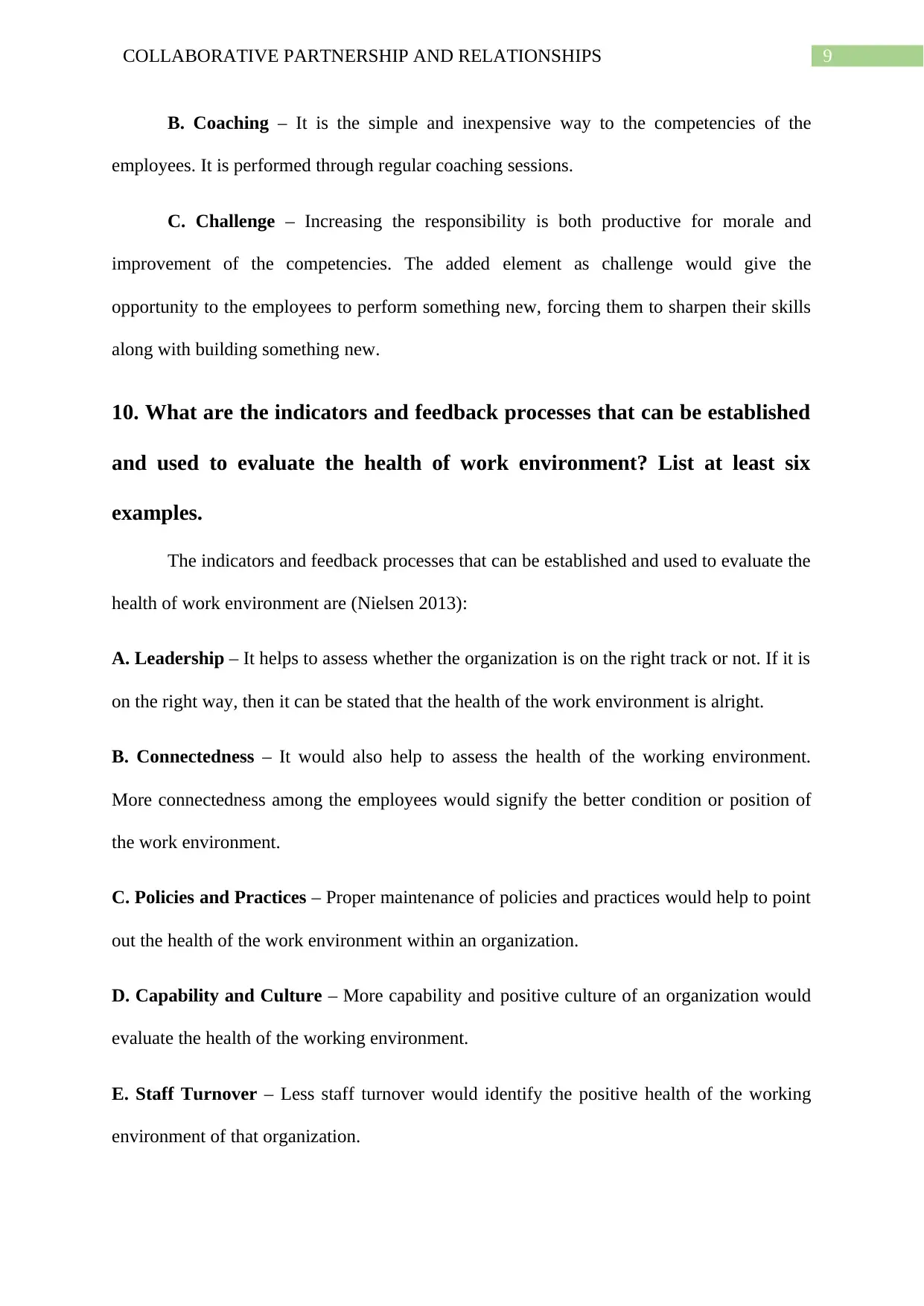
9COLLABORATIVE PARTNERSHIP AND RELATIONSHIPS
B. Coaching – It is the simple and inexpensive way to the competencies of the
employees. It is performed through regular coaching sessions.
C. Challenge – Increasing the responsibility is both productive for morale and
improvement of the competencies. The added element as challenge would give the
opportunity to the employees to perform something new, forcing them to sharpen their skills
along with building something new.
10. What are the indicators and feedback processes that can be established
and used to evaluate the health of work environment? List at least six
examples.
The indicators and feedback processes that can be established and used to evaluate the
health of work environment are (Nielsen 2013):
A. Leadership – It helps to assess whether the organization is on the right track or not. If it is
on the right way, then it can be stated that the health of the work environment is alright.
B. Connectedness – It would also help to assess the health of the working environment.
More connectedness among the employees would signify the better condition or position of
the work environment.
C. Policies and Practices – Proper maintenance of policies and practices would help to point
out the health of the work environment within an organization.
D. Capability and Culture – More capability and positive culture of an organization would
evaluate the health of the working environment.
E. Staff Turnover – Less staff turnover would identify the positive health of the working
environment of that organization.
B. Coaching – It is the simple and inexpensive way to the competencies of the
employees. It is performed through regular coaching sessions.
C. Challenge – Increasing the responsibility is both productive for morale and
improvement of the competencies. The added element as challenge would give the
opportunity to the employees to perform something new, forcing them to sharpen their skills
along with building something new.
10. What are the indicators and feedback processes that can be established
and used to evaluate the health of work environment? List at least six
examples.
The indicators and feedback processes that can be established and used to evaluate the
health of work environment are (Nielsen 2013):
A. Leadership – It helps to assess whether the organization is on the right track or not. If it is
on the right way, then it can be stated that the health of the work environment is alright.
B. Connectedness – It would also help to assess the health of the working environment.
More connectedness among the employees would signify the better condition or position of
the work environment.
C. Policies and Practices – Proper maintenance of policies and practices would help to point
out the health of the work environment within an organization.
D. Capability and Culture – More capability and positive culture of an organization would
evaluate the health of the working environment.
E. Staff Turnover – Less staff turnover would identify the positive health of the working
environment of that organization.
Paraphrase This Document
Need a fresh take? Get an instant paraphrase of this document with our AI Paraphraser
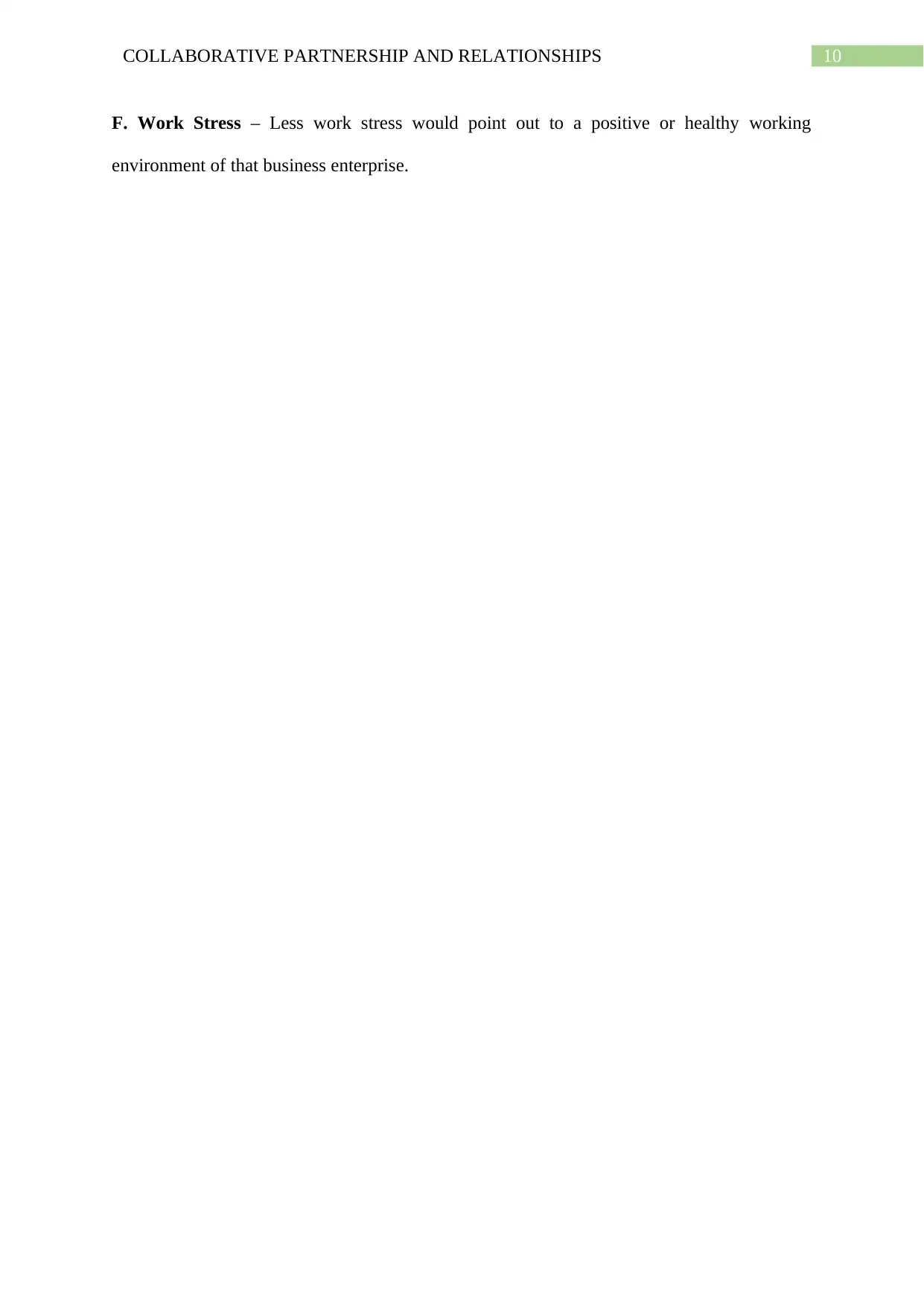
10COLLABORATIVE PARTNERSHIP AND RELATIONSHIPS
F. Work Stress – Less work stress would point out to a positive or healthy working
environment of that business enterprise.
F. Work Stress – Less work stress would point out to a positive or healthy working
environment of that business enterprise.
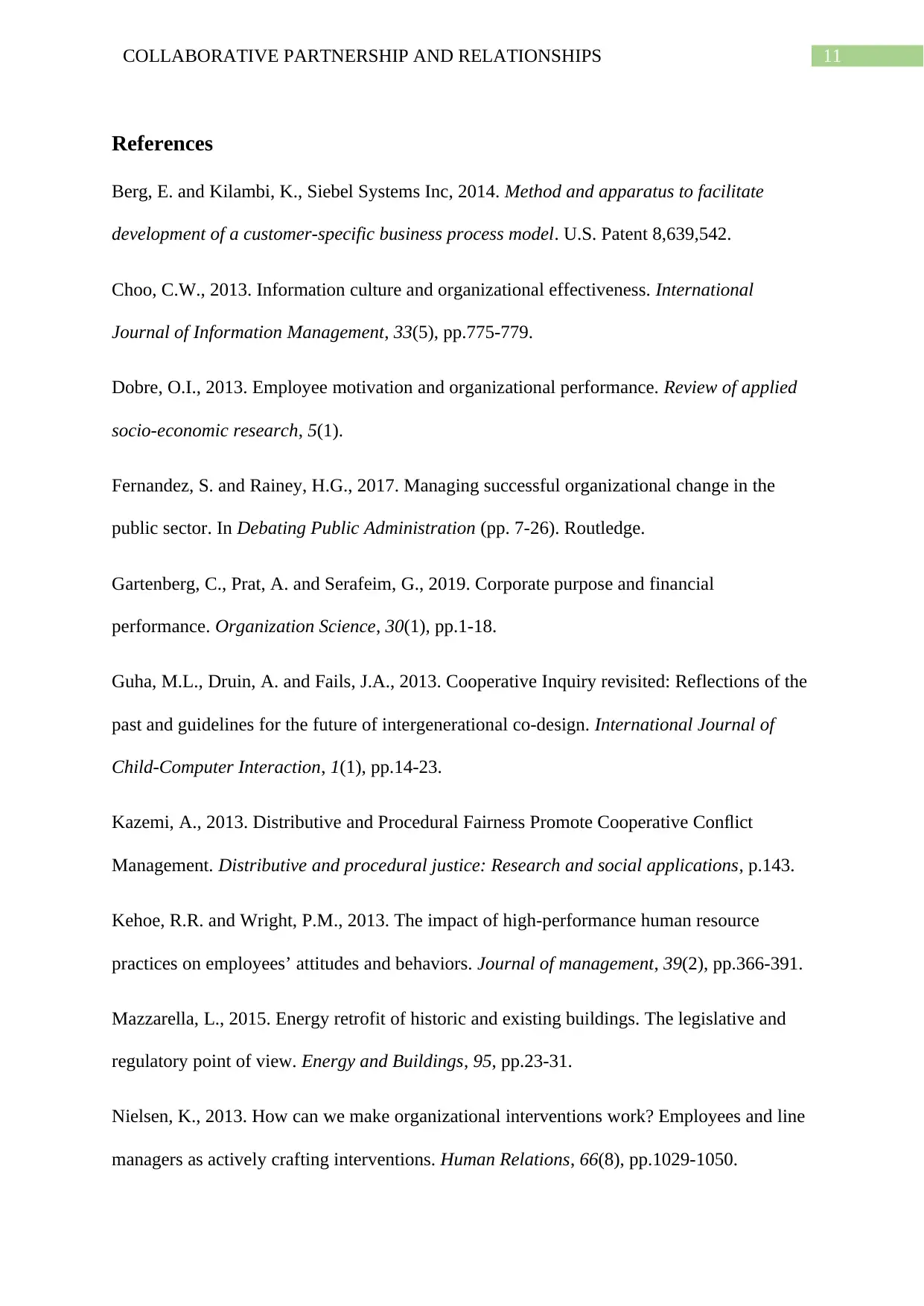
11COLLABORATIVE PARTNERSHIP AND RELATIONSHIPS
References
Berg, E. and Kilambi, K., Siebel Systems Inc, 2014. Method and apparatus to facilitate
development of a customer-specific business process model. U.S. Patent 8,639,542.
Choo, C.W., 2013. Information culture and organizational effectiveness. International
Journal of Information Management, 33(5), pp.775-779.
Dobre, O.I., 2013. Employee motivation and organizational performance. Review of applied
socio-economic research, 5(1).
Fernandez, S. and Rainey, H.G., 2017. Managing successful organizational change in the
public sector. In Debating Public Administration (pp. 7-26). Routledge.
Gartenberg, C., Prat, A. and Serafeim, G., 2019. Corporate purpose and financial
performance. Organization Science, 30(1), pp.1-18.
Guha, M.L., Druin, A. and Fails, J.A., 2013. Cooperative Inquiry revisited: Reflections of the
past and guidelines for the future of intergenerational co-design. International Journal of
Child-Computer Interaction, 1(1), pp.14-23.
Kazemi, A., 2013. Distributive and Procedural Fairness Promote Cooperative Conflict
Management. Distributive and procedural justice: Research and social applications, p.143.
Kehoe, R.R. and Wright, P.M., 2013. The impact of high-performance human resource
practices on employees’ attitudes and behaviors. Journal of management, 39(2), pp.366-391.
Mazzarella, L., 2015. Energy retrofit of historic and existing buildings. The legislative and
regulatory point of view. Energy and Buildings, 95, pp.23-31.
Nielsen, K., 2013. How can we make organizational interventions work? Employees and line
managers as actively crafting interventions. Human Relations, 66(8), pp.1029-1050.
References
Berg, E. and Kilambi, K., Siebel Systems Inc, 2014. Method and apparatus to facilitate
development of a customer-specific business process model. U.S. Patent 8,639,542.
Choo, C.W., 2013. Information culture and organizational effectiveness. International
Journal of Information Management, 33(5), pp.775-779.
Dobre, O.I., 2013. Employee motivation and organizational performance. Review of applied
socio-economic research, 5(1).
Fernandez, S. and Rainey, H.G., 2017. Managing successful organizational change in the
public sector. In Debating Public Administration (pp. 7-26). Routledge.
Gartenberg, C., Prat, A. and Serafeim, G., 2019. Corporate purpose and financial
performance. Organization Science, 30(1), pp.1-18.
Guha, M.L., Druin, A. and Fails, J.A., 2013. Cooperative Inquiry revisited: Reflections of the
past and guidelines for the future of intergenerational co-design. International Journal of
Child-Computer Interaction, 1(1), pp.14-23.
Kazemi, A., 2013. Distributive and Procedural Fairness Promote Cooperative Conflict
Management. Distributive and procedural justice: Research and social applications, p.143.
Kehoe, R.R. and Wright, P.M., 2013. The impact of high-performance human resource
practices on employees’ attitudes and behaviors. Journal of management, 39(2), pp.366-391.
Mazzarella, L., 2015. Energy retrofit of historic and existing buildings. The legislative and
regulatory point of view. Energy and Buildings, 95, pp.23-31.
Nielsen, K., 2013. How can we make organizational interventions work? Employees and line
managers as actively crafting interventions. Human Relations, 66(8), pp.1029-1050.
⊘ This is a preview!⊘
Do you want full access?
Subscribe today to unlock all pages.

Trusted by 1+ million students worldwide
1 out of 13
Related Documents
Your All-in-One AI-Powered Toolkit for Academic Success.
+13062052269
info@desklib.com
Available 24*7 on WhatsApp / Email
![[object Object]](/_next/static/media/star-bottom.7253800d.svg)
Unlock your academic potential
Copyright © 2020–2025 A2Z Services. All Rights Reserved. Developed and managed by ZUCOL.




